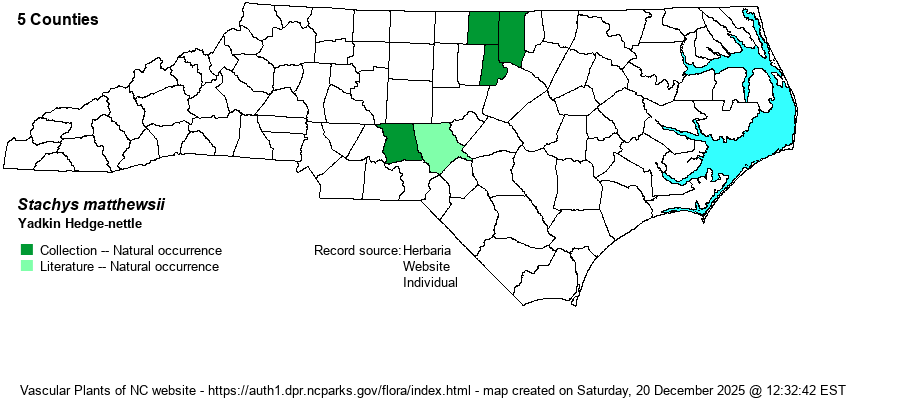| Author | G.P. Fleming, J.B. Nelson, & J.F. Townsend | |
| Distribution | A recently described (2011) and easily confused species, collected so far only from several sites in the eastern Piedmont, from Person, Granville, and Durham counties to Montgomery County; photos by Eric Ungberg and verified by John Nelson, from Moore County in 2021.
It is a VA and NC endemic, ranging from central VA south to central NC.
| |
| Abundance | Very rare to rare, and very poorly known, as it was only just described in 2011; some biologists might have seen it in the past, and considered it as S. aspera, for example. This is a State Endangered species, with a State Rank of S1. As many records for "S. aspera" in the northeastern Piedmont might actually be S. matthewsii, the website editors suggest a State Rank of S1S2. Interestingly, NatureServe does not add a "?" to the Global Rank for Questionable taxonomy, and ranks it as G1G2. | |
| Habitat | "In sandy alluvium along forest edges in river floodplains" (Weakley 2018). It also has been found in moist wooded margins and other damp ground in open to partly open places. | |
| Phenology | Blooms from June to August, and fruits from July to September (presumably). | |
| Identification | This is a very confusing species, and is most similar to several montane species, and to S. hispida and S. aspera, which are also very poorly known in NC and the East. It is a standard Stachys, with some hairs on the edges, and numerous paired leaves. In this species, the leaves are essentially sessile, elliptical, with the widest part in the middle (if not slightly above the middle), but not clearly below the middle as in the more lanceolate-leaved S. aspera. Also, the leaf margins are crenate (rounded teeth), as opposed to sharp teeth in some others. Weakley's (2018) key also mentions "lower stem angles copiously pubescent with 3-celled spreading hairs". It should be noted that there is some confusion with one or more species, as a few specimens labelled recently as S. matthewsii have narrow leaves or leaves clearly lanceolate and widest below the middle; these tend to be specimens collected from the Durham Diabase Sill region of Granville and Durham counties -- seemingly somewhat intermediate between this species and S. aspera. | |
| Taxonomic Comments | See above; this is a recently described species. In reality, it probably consists of plants that were formerly included within S. aspera, S. hispida, and S. latidens, if not others.
Stachys is a large and complex genus that is still actively being worked on, and our understanding of the species is slowly being clarified. For interested readers, we recommend journal papers by Nelson (1981, 2008) and by Fleming et al. (2011). | |
| Other Common Name(s) | None | |
| State Rank | S1 | |
| Global Rank | G1G2 | |
| State Status | E | |
| US Status | | |
| USACE-agcp | | |
| USACE-emp | | |

